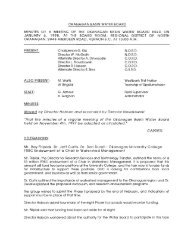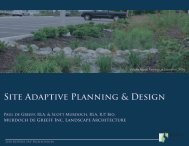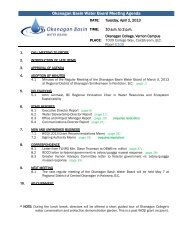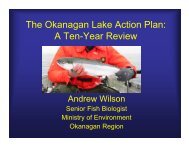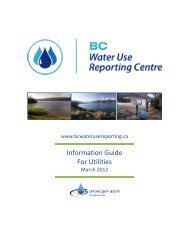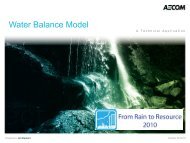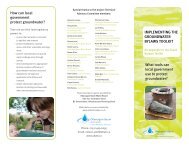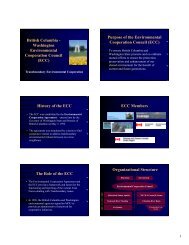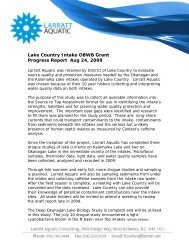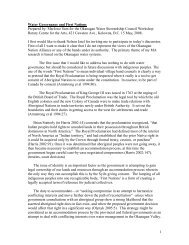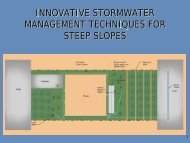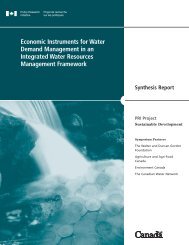Instream Flow Needs Analysis - Okanagan Basin Water Board
Instream Flow Needs Analysis - Okanagan Basin Water Board
Instream Flow Needs Analysis - Okanagan Basin Water Board
- No tags were found...
Create successful ePaper yourself
Turn your PDF publications into a flip-book with our unique Google optimized e-Paper software.
FINAL<strong>Okanagan</strong> <strong>Basin</strong> <strong>Instream</strong> <strong>Flow</strong> <strong>Needs</strong>Freshet: Increased flows caused by melting snows or rainGroundwater: In general, all subsurface water that is distinct from surface water; specifically, that partwhich is in the saturated zone of a defined aquifer.Hydrograph: A graph showing the variation in discharge (flow) over time.IFIM: The <strong>Instream</strong> <strong>Flow</strong> Incremental MethodologyIndigenous: A fish or other aquatic organism native to a particular water body, basin, or region.<strong>Instream</strong> flow: Any quantity of water flowing in a natural stream channel at any time of year. Thequantity may or may not be adequate to sustain natural ecological processes and may or may not beprotected or administered under a permit, water right, or other legally recognized means.<strong>Instream</strong> flow need (IFN): The amount of water flowing through a natural stream course that is neededto sustain, rehabilitate, or restore the ecological functions of a stream in terms of hydrology,geomorphology, biology, water quality, and connectivity.Larvae: Immature forms that must pass through one or more metamorphic changes before becoming anadult.Life stage: An arbitrary age classification of an organism into categories related to body morphology andreproductive potential, such as spawning, egg incubation, larva or fry, juvenile, and adult.Mainstem: The main channel of a river, as opposed to tributary streams and smaller rivers that feed intoit.Mean annual discharge (MAD): The rate of streamflow or the volume of water flowing at a location forthe individual year or multi-year period of interest. MAD is obtained by dividing the sum of all theindividual daily flows by the number of daily flows recorded for the year. If mean annual flows areavailable for each year of the record, their sum may be divided by the number of years of record toobtain the long-term mean annual flow for the period of record.Metapopulation: a group of spatially separated populations of the same species which interact at somelevel and regularly exchange genes.Minimum flow: The lowest streamflow required to protect some specified aquatic function as establishedby agreement, rule, or permit.Natural flow: The flow regime of a stream as it would occur under completely unregulated conditions;that is, not subjected to regulation by reservoirs, diversions, or other human works.Natural hydrograph: A graph showing the variation in discharge (or river stage) that would exist in theabsence of any human alteration, over a specific time period.Naturalized flow: Measured flows that are adjusted for upstream water licenses or uses to approximatethe flows that would occur in the absence of regulation and extraction.Nodes: Areas that have been defined within the <strong>Okanagan</strong> <strong>Basin</strong>, consisting of key tributaries (at theirmouths), mainstem lakes, residual areas and key locations on the <strong>Okanagan</strong> River. These representthe fundamental spatial units governing surface water for the purposes of the Phase 2 <strong>Okanagan</strong><strong>Water</strong> Supply and Demand project.Optimum flows for fish (OFF): Stream flows that maximize the limiting or critical habitat for a specificfish species according to hydraulic suitability criteria using depth, velocity and substrate in aweighted useable area or weighted useable width analysis (WUA or WUW). Although optimumflows are not a mandatory requirement for flow management, they are a useful benchmark todetermine the relationships among flow, habitat availability and fish production potential.xvESSA Technologies Ltd. &Solander Ecological Research




